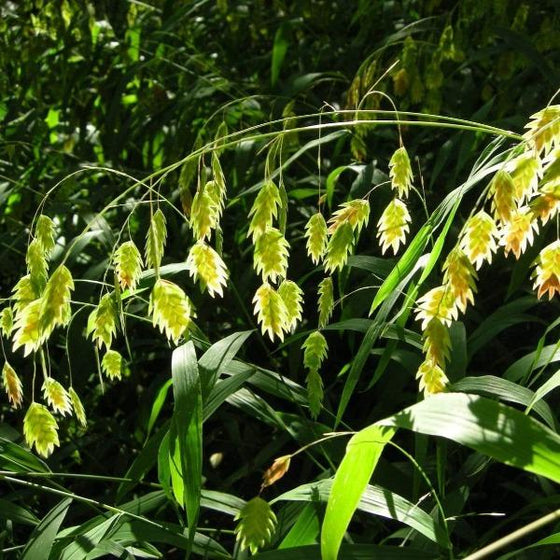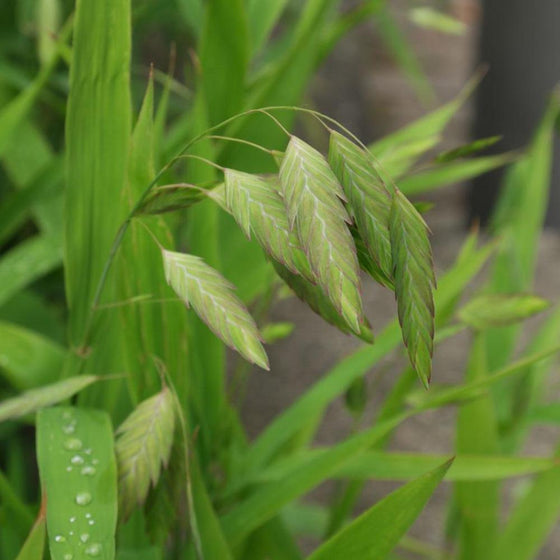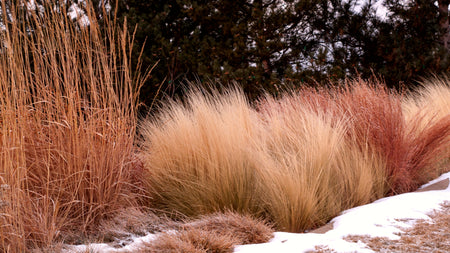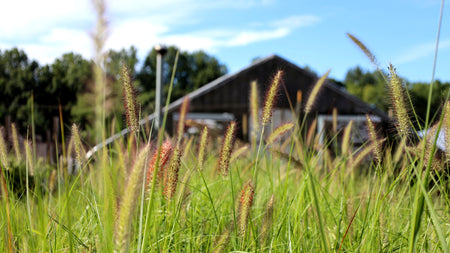
Images Depict Mature Plants
Northern Sea Oats for Sale Online
Northern Sea Oats (Chasmanthium latifolium) is a versatile, clump-forming ornamental grass prized for its unique, flat, oat-like seed heads and graceful arching foliage. This warm-season grass thrives in USDA Hardiness Zones 5-9 and reaches a mature height of 2 to 3 feet, with a similar spread. Its distinctive seed heads emerge in summer, turning from green to bronze as they mature, providing both visual interest and texture in the garden. Northern Sea Oats is an excellent choice for adding movement and structure to the landscape, as its seed heads sway gently in the breeze.
Ideal for shady or partially shaded areas, Northern Sea Oats thrive in a variety of soil conditions, including moist or dry soils, making them highly adaptable plants for gardens, borders, and woodland settings. Its arching, bamboo-like foliage turns a rich bronze or copper in fall, extending its beauty into the cooler months. The attractive seed heads persist into winter, offering additional ornamental value and providing food for birds. Northern Sea Oats is also drought-tolerant once established, making it a low-maintenance option for naturalizing in gardens or along water features.
In addition to its ornamental value, Northern Sea Oats is a practical choice for erosion control on slopes or along stream banks due to its deep root system. Its non-invasive clumping habit ensures it stays well-behaved in garden settings. This deer-resistant grass works beautifully in mass plantings, mixed borders, or as a focal point in containers. Whether you want to create a naturalized garden, provide food and shelter for wildlife, or add year-round interest, Chasmanthium latifolium is a reliable, attractive option for any landscape.
The seed heads of Northern Sea Oats add both sound and movement to the winter garden, bringing a dynamic element to otherwise still landscapes. As the oat-like seed heads mature and dry, they sway gracefully in the breeze, creating a gentle rustling sound that adds a soothing, natural ambiance. These delicate movements, combined with the bronze and copper hues of the seed heads, capture the light and bring life to the garden, even in the coldest months. The persistent seed heads remain standing through winter, offering not only visual interest but also a subtle auditory experience, enhancing the sensory appeal of your winter garden.
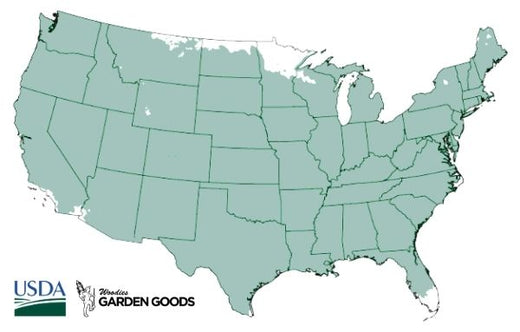
| Hardiness Zone: | 5-9 |
|---|---|
| Mature Height: | 3 Feet |
| Mature Width: | 2 to 3 Feet |
| Sunlight: | Full Sun to part shade |
| Water Requirements: | Average to wet |
| Selling Points: | Erosion control, native, deer Resistant, drought Tolerant, salt Tolerant, fall interest |
How to Care for Northern Sea Oats
Before you buy Northern Sea Oats, be sure to read about the recommended care instructions to ensure your plant stays happy and healthy for years to come!
How Do I Plant Northern Sea Oats?
To plant Northern Sea Oats (Chasmanthium latifolium), start by selecting a location with partial shade to full shade, as this ornamental grass thrives in lower light conditions. Northern Sea Oats is highly adaptable and prefers well-drained soil but can also tolerate a range of soil types, including sandy, loamy, or clay soils. Begin by loosening the soil to a depth of about 6-8 inches to encourage root growth. Dig a hole large enough to accommodate the root ball, ensuring the top of the root ball is level with the soil surface. Place the plant in the hole, backfill with soil, and water thoroughly to help it establish. Adding a layer of mulch around the base of the plant helps retain moisture and suppress weeds, especially in the early stages. When planting multiple Northern Sea Oats for a naturalized look or erosion control, space the plants about 18-24 inches apart to allow room for growth and spreading. This spacing encourages the plants to fill in naturally over time, creating a lush, textured ground cover or border. Keep the soil consistently moist during the first growing season to help the roots establish, but once Northern Sea Oats is established, it becomes drought-tolerant and low-maintenance. Whether planted along stream banks, in woodland gardens, or as a feature in mixed borders, this ornamental grass brings movement, texture, and year-round interest to the landscape.
How Do I Water Northern Sea Oats?
Watering Northern Sea Oats properly is key to helping it establish strong roots and maintain healthy growth. During the first growing season, it’s important to keep the soil consistently moist, especially in hot or dry conditions. Water deeply once or twice a week, depending on rainfall, ensuring the top 2-3 inches of soil remain damp but not waterlogged. This deep watering encourages root development, helping Northern Sea Oats establish more quickly. It thrives in moist, well-drained soils but is also adaptable to various conditions, including areas that experience occasional flooding or drought. Once Northern Sea Oats is established, it becomes more drought-tolerant and requires less frequent watering. In normal conditions, it can handle periods of dry weather, but in extended droughts, you should water occasionally to maintain its lush green appearance. Mulching around the base of the plant can help retain moisture and reduce the need for frequent watering. Whether planted along stream banks, in woodland settings, or as part of a landscape border, Chasmanthium latifolium responds best to consistent moisture during its early growth while becoming more resilient as it matures.
How Do I Fertilize Northern Sea Oats?
To fertilize Northern Sea Oats, start by applying a balanced, slow-release fertilizer in early spring as new growth begins to emerge. A general-purpose fertilizer with a 10-10-10 ratio works well to promote healthy foliage and root development. Spread the fertilizer evenly around the base of the plant, making sure to avoid direct contact with the crown to prevent burn. Water thoroughly after applying the fertilizer to help the nutrients penetrate the soil and reach the roots. This spring feeding will encourage lush growth and vibrant seed heads that will last throughout the season. For ongoing care, you can also incorporate organic compost or well-rotted manure into the soil around Northern Sea Oats to provide slow-release nutrients over time. This improves soil quality and adds essential minerals to help maintain the plant’s vigor. Avoid over-fertilizing, as this grass typically requires minimal additional nutrients once established, and excessive feeding can lead to overly vigorous growth. A light application in spring is usually sufficient for maintaining Chasmanthium latifolium as a healthy, low-maintenance ornamental grass in borders, woodland gardens, or areas prone to erosion.

How Do I Prune Northern Sea Oats?
Pruning Northern Sea Oats is a simple process that helps maintain its appearance and promotes healthy growth. The best time to prune is in late winter or early spring, before new growth begins. Use clean, sharp pruning shears to cut back the dried foliage and seed heads to about 2-3 inches above the ground. This pruning encourages fresh growth and allows the plant to regenerate fully in the spring. Removing the spent seed heads also prevents excessive self-seeding, as Northern Sea Oats can spread readily in ideal conditions. Throughout the growing season, you can also perform light pruning to remove any damaged or diseased foliage. This helps the plant maintain a neat appearance and encourages airflow, reducing the risk of fungal diseases. Avoid heavy pruning during the growing season, as Northern Sea Oats thrives when allowed to grow naturally, with its graceful seed heads swaying in the breeze. Regular pruning in early spring ensures that this ornamental grass will provide attractive, arching foliage and oat-like seed heads throughout the growing season, making it a beautiful and low-maintenance addition to any landscape.

